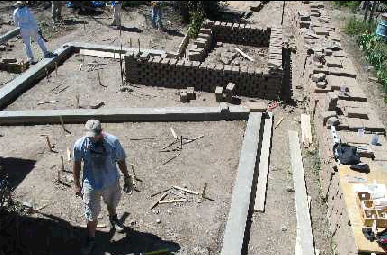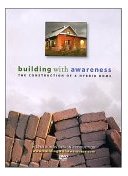On November 4-6, 2005, The Adobe Alliance will offer an intensive vault-building workshop. The group shall be limited to 20. We will build, as usual by hand, the beginnings of a vault since it takes two weeks to complete one. The first courses are the most difficult as it is essential to master the technique of inclining the first bricks properly against the back wall which will support part of the load of the vault (most of the load descends in exquisite equilibrium into the 18″ width of the earthen brick wall.) Hands-on instruction is given by project manager/ adobera Jesusita Jimenez and theory by Simone Swan, designer.Bring work clothes, hat, gloves, heavy shoes, sun protection, a bucket, a float and water. Primitive camping available on site but without water. Lodgings are available in Presidio and Ojinaga, Mexico (across the bridge). Potluck meals at Swan House and/or Thai catering. Participants are also invited during the three weeks prior to the workshop in order to build the sustaining walls for the vaulted roof. Interns receive room and board, first come first served! If an intern wishes to join our work in plastering between November 6th and 10th, please write us. Cost is $250 by October 20, $300 thereafter. Scholarships available. Download poster (PDF)
AREA: Design + Build in Marfa, Texas

PROGRAM DATES FOR AREA SUMMER DESIGN+BUILD
June 1 – July 1 2005
AREA is a summer research+build workshop that engages a 90 year old abandoned mud-brick building, located in the town of Marfa, Texas, as the testing grounds for questioning the notion of detail, the theme of this years inquiry. Through a series of explorations that examine the process of making and unmaking in architecture, participants will design and build full-scale interventions that respond to a critical examination of place and program while addressing local/global and industrial/non-industrial agendas for architecture by employing raw earth as the primary building material in these investigations. Marfa serves as an ideal laboratory from where to study these issues. It is a town constructed almost entirely from mud-brick and transformed by rich historical, cultural and geographic forces. At 5,000 feet above sea level, it is one of the oldest cultivated areas in the United States. Located 60 miles from the U.S./Mexico border, Marfa is also home to the Chinati Foundation, an internationally renowned contemporary art museum, founded by Donald Judd, whose emphasis is on works in which art and the surrounding landscape are inextricably linked. Participants will have the opportunity to visit this extraordinary cultural and geographic landscape through a series of directed and self-guided field-studies. AREA is an initiative of the School of Architecture at Clemson University and made possible in part by the Adobe Alliance, a non-profit organization committed to the dissemination of traditional earth building technologies.
MORE INFORMATION AT: www.areainstitute.org
The Construction of a Hybrid Home

Building With Awareness: The Construction of a Hybrid Home is “the most comprehensive video ever made on the design and construction of a green home” in New Mexico. The DVD contains contains a 2 hr. 45 min. video which contains information on adobe construction and earthen plasters. Watch quicktime trailers of the DVD.
Living in Earthen Cities – kerpic’05 Cities Conference
The “Living in Earthen Cities – kerpic’05” congress is to be held at Istanbul Technical University , July 6-7 in Istanbul, Turkey. The focus of the congresses has evolved from quality of life in earthen architecture, environmental and health care, towards disaster prevention. The congress organizers hope that it will bring together the related disciplines of architects and engineers, on material, construction, marketing and environmental science, to create database, technology watch and strategy. The workshop will cover the entire construction activities of alker (gypsum stabilized earthen material), where all the participants can take part. Social and cultural program will offer interesting historical tour; distinguished dinner will welcome you on Bosphorus. Visit the Congress Website
Adobe Alliance Workshop
The Adobe Alliance is pleased to announce the 7th annual workshop in Presidio, TX. Vault building and earth plastering will be featured during the workshop which takes place February 18-20, 2005. Demonstrations on applying a water-resistant exterior plaster of clay, straw, cactus juice and horse manure which breathes with the environment, which has withstood superbly in the unseasonally heavy rains of summer 2004 in the Big Bend.
Lodgings are easily booked at The Riata (432 229 2528) in Presidio, the Three Palms (432 229 3211,) or you can explore across the bridge a few minutes into Ojinaga, Mexico, a city of 25,000 people. The Paisano Hotel in Marfa is 60 miles to the north. There are many restaurants on both sides of the river.
For more information contact the Adobe Alliance.
Modern Earth Building 2005
The MODERN EARTH BUILDING 2005 – International conference and fair will be held on the 18th to 20th of November 2005 in Berlin. Again visitors learn about new developments in earthen architecture. The business field of earth building products is increasing in the last years and new technological developments can be presented. The aim of the conference is to enhance the earthen architecture and culture.
Contact and information:
Umbra GmbH
Peter Steingass
Rigaer Stra?e 29 A, 10247 Berlin
Telefon: ++49-30 / 61 62 55 48
Telefax: ++49-30 / 61 62 55 49
info@lehmbauforum.com
www.lehmbauforum.com
Conference on Rammed Earth Construction
To coincide with launch of the new publication Rammed earth: design &
construction guidelines, a one-day conference on rammed earth construction
is to be held on Wednesday 9th February 2005 in the Department of Architecture & Civil Engineering at the University of Bath.
The conference will examine historic and modern use of rammed earth in the
UK and Europe, practical issues of construction applications, material
testing and selection, formwork and construction, engineering design,
architectural design and detailing, maintenance and repair of walls. The
workshop is open to architects, engineers, designers, building surveyors,
construction companies, property developers, researchers and interested
individuals.
Issues for discussion will include thermal performance, durability, material
strength, cement stabilisation, building control, quality testing and wall
finishes. Case studies from recent rammed earth projects in the UK and
Europe will be presented. Findings from recent research work will also be
outlined. The workshop will also include an exhibition and practical
demonstration of rammed earth construction.
Rammed earth: design & construction guidelines is the result of a DTi
sponsored research and innovation programme investigating the potential of
rammed earth for new construction.
Conference speakers include:
Martin Rauch, Baukunst GmbH
Lars Allan Palmgren, Architect
Rowland Keable, Insitu Rammed Earth Co. Ltd
Pat Borer, Architect
Gordon Pearson
Tom Morton, ARC Architects
Andy Simmonds, Simmonds-Mills Architect Builders
Mark Lovell, Mark Lovell Design Engineers
Jonathan Hines, Architype
Mark Swenarton, Architecture Today
Peter Trotman, BRE
Paul Ellis, Ecology Building Society
Joe Martin, JM Architects
Steve Goodhew, University of Plymouth
Peter Walker, University of Bath
To reserve a place please: email P.Walker@bath.ac.uk, telephone 01225
386646, or fax 01225 386691. Alternatively send your name and contact
details to Peter Walker, Department of Architecture & Civil Engineering,
University of Bath, Claverton Down, Bath, BA2 7AY, UK. Download the conference brief in .pdf format.
Preliminary programme:
Registration 8.30 AM
Opening presentations (Introduction; Historical bakcground; Applications;
Materials): 9.00-10.45 AM
Coffee break: 10.45-11.15 AM
Presentations (Construction; Design; Maintenance & Repair): 11.15 AM – 12.45
PM
Lunch: 12.45-2.00 PM
Presentations (Case studies I): 2.00-3.20 PM
Coffee break: 3.20-3.45 PM
Closing presentations (Case studies II; Research work) and discussion:
3.45-5.00 PM
Full day registration fee: £105.00
Concessionary registration fee: £80.00 (AECB members; full-time students)
Morning or afternoon half-day fee (without lunch): £65.00 (£50.00 conc.)
Registration includes a copy of the Rammed earth: design & construction
guidelines.
SismoAdobe2005
The Department of Engineering of the Catholic University of Peru (PUCP) is organizing an International Seminar of Architecture, Construction and Conservation of Earthen Buildings in Seismic Areas. The seminar is sponsored by Proterra (a Research Project of CYTED), the Earthquake Engineering Research Institute (EERI), and the Getty Conservation Institute (GCI).
This event will take place on the PUCP campus, from 16-19 May 2005. It will include keynote conferences from international experts, oral and poster presentations, and technical demonstrations at the Structures Laboratory of the PUCP, where full-scale seismic simulation tests of adobe dwellings will be performed.
You are welcome to visit the website of SismoAdobe2005 at www.pucp.edu.pe/eventos/SismoAdobe2005 for more information.
American Adobes

American Adobes by Beverly Spears documents the rich and distictly Northern New Mexican vernacular house.
Earth Architecture in Venezuela

Arquitectura de Tierra Cruda en Venezuela contains 257 color and 24 black and white illustrations discusses the use of earthen architecture in Venezuela from the pre-columbian period to today. Spanish language edition only.
